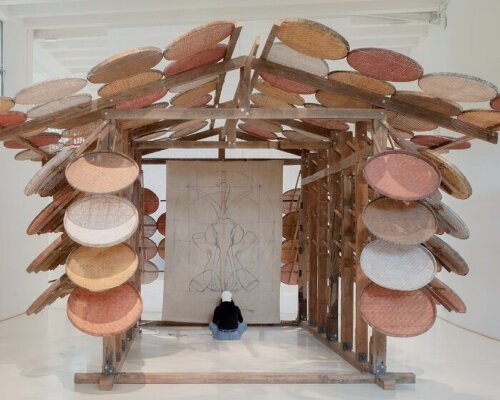handwoven bamboo winnowing wraps elephant food house
In Taklang Village, northeastern Thailand, elephants and people have lived side by side for over 400 years, and today, more than 200 elephants now share the land with human residents. This coexistence is the starting point for Boonserm Premthada’s Elephant Food House presented at the 24th International Exhibition of Triennale Milano. Responding to the growing crisis of elephant food scarcity in Thailand, a problem tied to deforestation, disrupted crop cycles, and climate change, the Thai architect and designer’s work combines architecture, ecology, and local craft.
The project proposes a humble form of interdependence, made of reconfigured rice barns once used to store grain for human consumption and now serving as food shelters for elephants, bridging two species through the same basic need. The barns are airy and lightweight, built with timber frames and encased in handwoven bamboo winnowing baskets‚ traditional agricultural tools that have been scaled up and recontextualized. With surfaces that are breathable and lightweight, they offer ventilation and protection while making the craft of the region visible.
all images by Simone Bossi
boonserm premthada addresses thai elephant food shortage
Inside the Elephant Food House at the Triennale Milano, partially enclosed on three sides, Boonserm Premthada places a sculpture of a Vitruvian elephant, formed from paper made with elephant dung — ‘the very material where my elephant-centered and nature-centered design began,’ the architect notes. In placing this figure across from the shelter’s entrance, the gesture ties the cycle of nourishment and waste into a closed loop, reflecting Premthada’s stance that the built environment should be shaped by sensitivity. ‘Inequality, in my view, is not about granting rights to animals but about fostering empathy that humans should have for other living beings,’ he shares. ‘Maintaining balance in the ecosystem is something humans must consciously uphold. In the past, we have only pursued our convenience, overlooking the world around us.’
As such, the project’s origins lie in a response to a long-standing environmental and ecological issue in Thailand: the steady decline of food sources for elephants caused by deforestation, land development, human encroachment, and more recently, climate change. In Taklang village, the surrounding forest once provided the primary source of nutrition for its vast elephant population, though, over the years, that reserve of fertile land has become increasingly depleted. The Food Houses were thus developed in response and as part of a local system of care, scattered along forest paths as collection points where villagers bring bundles of fresh plants for the elephants to eat.
Boonserm Premthada presents Elephant Food House at the 24th International Exhibition of Triennale Milano
mediating coexistence through architecture at triennale milano
In addition to supplementing the elephants’ diets, the walks to the shelters support digestion and overall health, reinforcing a rhythm of movement and interaction between species. The shelters also function as shaded resting points for humans and elephants alike, along routes once integral to foraging and seasonal migration.
Now shown at Triennale Milano under the theme Inequalities, the Elephant Food House retains its original intent, highlighting the ecological pressures faced by elephants as well as the broader systems that shape how species live together, or fall out of balance. It repositions structures typically designed for human use as shared, interspecies resources, suggesting architecture’s role in mediating coexistence. Boonserm Premthada refers to this as a ‘Human and Non-Human Nation’ — a framework that centers humans as part of a broader, entangled ecology.
responding to the growing crisis of elephant food scarcity in Thailand
encased in handwoven bamboo winnowing baskets‚ traditional agricultural tools
the project is made of reconfigured rice barns once used to store grain for human consumption
with surfaces that are breathable and lightweight, they offer ventilation and protection
the traditional barns are airy and lightweight, built with timber frames
the shelters in Thailand also function as shaded resting points for humans and elephants alike
project info:
name: Elephant Food House
architect: Boonserm Premthada | @boonserm_premthada
location: Milan, Italy
event: 24th Triennale Milano International Exhibition
dates: 13th May—9th November, 2025
photographer: Simone Bossi | @simonebossiphotographer
The post boonserm premthada upcycles thai rice barns for elephant food shelter at triennale milano appeared first on designboom | architecture & design magazine.

